War and Women’s Human Rights Museum
전쟁과여성인권박물관
Hidden in the backstreets of Seoul is one of South Korea’s most poignant and memorable museums the “War and Women’s Human Rights Museum“.
This beautifully and thoughtfully presented museum reveals the distressing and largely untold story of the thousands of Korean “comfort women” enslaved and abused by the Japanese Army before and during the Second World War. A must-visit museum for feminists and women’s rights supporters.
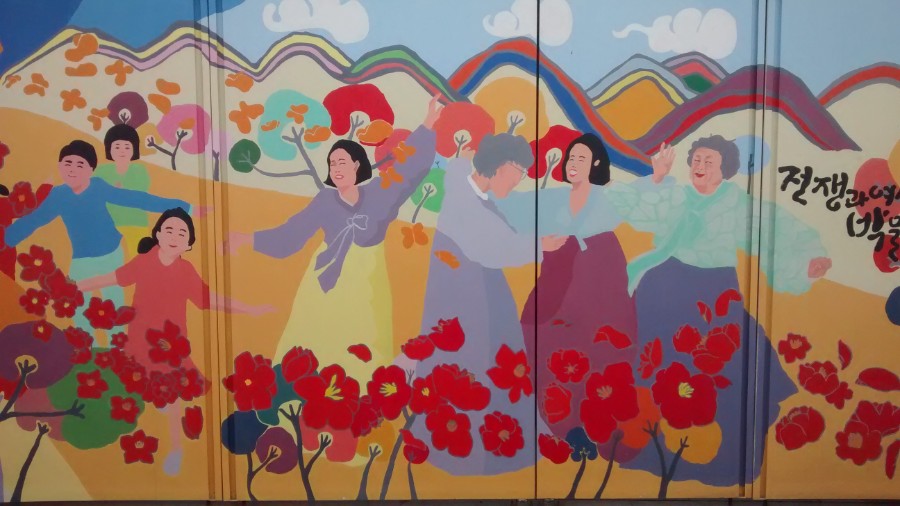
A mural of hope for all South Korean women and future generations
Who are the South Korean “Halmoni” and why does their story matter?
The Korean word ‘Halmoni‘ literally translates as ‘grandmother’ in English. Halmoni is the term that thousands of former ‘comfort women’ now in their eighties and nineties have chosen as their collective name. As ‘grandmothers’ themselves, these brave survivors of some of the most brutal events of recent history, are now ‘grandmothers of the nation‘. Sharing their stories and memories to educate the next generations.
During the Asia-Pacific War (1930s-1945), the Korean Peninsular was under the control of Japan. The Japanese military kidnapped thousands of young girls and women and forced them into sexual slavery. The testimonials that survive, both written and oral, are shocking. The Japanese military had official systems, procedures and currency (in the form of vouchers) in place to ‘allocate’ their prisoners ‘services’.
Throughout the War and Women’s Human Rights Museum, there are hundreds of testimonials from former ‘comfort women’ from all around Asia. Although the majority were Koreans, many women from the Philippines, Malaysia and European women resident in SE Asia were enslaved. The women once under the control of the Japanese were moved around like cattle to wherever the Japanese Army was fighting.
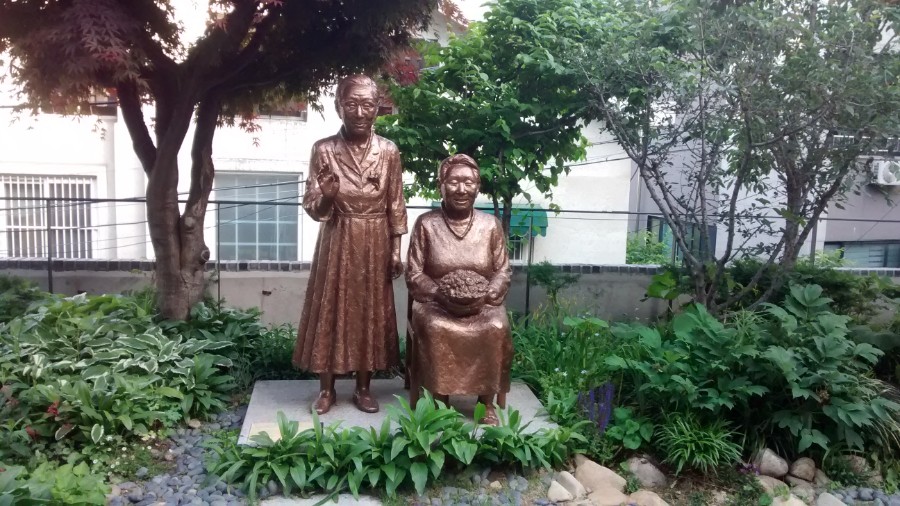
Perhaps the saddest and most tragic part of many of the survivors’ stories is that they never made it home. Hundreds were massacred and many of those who survived were abandoned at the end of the war.
1945 brought peace but it also brought massive upheaval, confusion and exodus. Young, lost and alone in a strange land without the money or the knowledge to return home to Korea, many young women tried to forge new lives for themselves.
There are dramatic tales of former comfort women abandoned in Thailand and Okinawa suddenly hearing Korean years later. Upon hearing their native language for the first time in decades, it unleashed a flood of hidden memories and encouraged the survivors to finally seek support and remember their own histories.
How the War and Women’s Human Rights Museum represents the tragedy of the ‘Halmoni’?
Housed in a small location in the residential backstreets on urban Seoul, the War and Women’s Human Rights Museum is a powerful place to visit. Not just the thought-provoking exhibits but the very essence of the physical experience has been considered.
Claustrophobic, dark alleyways paved with hard gravel stones and stone faces peering out of the concrete walls invoke the feelings of apprehension and dread of the young kidnapped women. Stark concrete walls, bare bricks and black and white photographs of victims all create a sense of discomfort and looming tragedy as you make your way through the first exhibits.
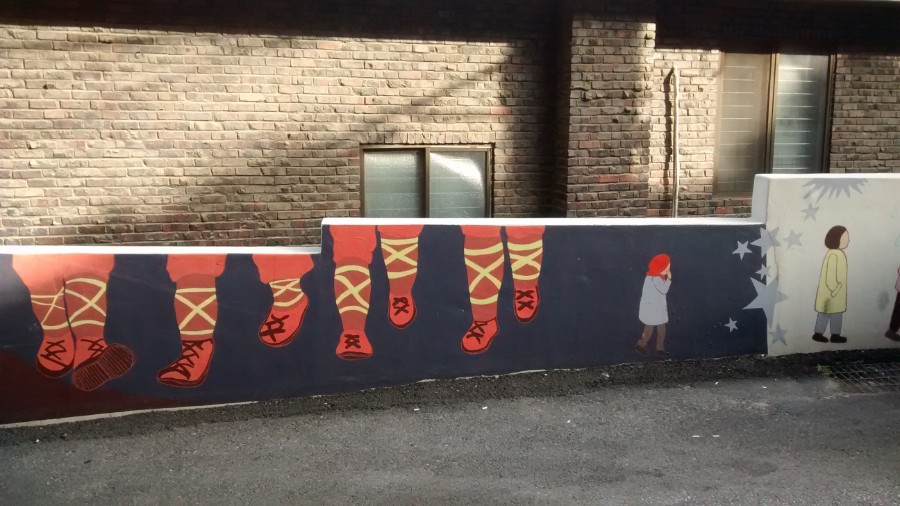
Moving mural showing Japanese soldiers marching past a scared young girl
**You are strongly discouraged from taking photos in the War and Women’s Human Rights Museum. All my photos are of outside the museum or of statues that you are permitted to photograph**
The World-Famous Wednesday Protests
Every Wednesday since 1992, a group of survivors of Japanese Military Sexual Slavery have protested in front of the Japanese Embassy in Seoul. Demanding that the Japanese government recognise them and officially apologise to the Korean people. If you are interested in taking part in one of these peaceful protests, scroll down for more information.
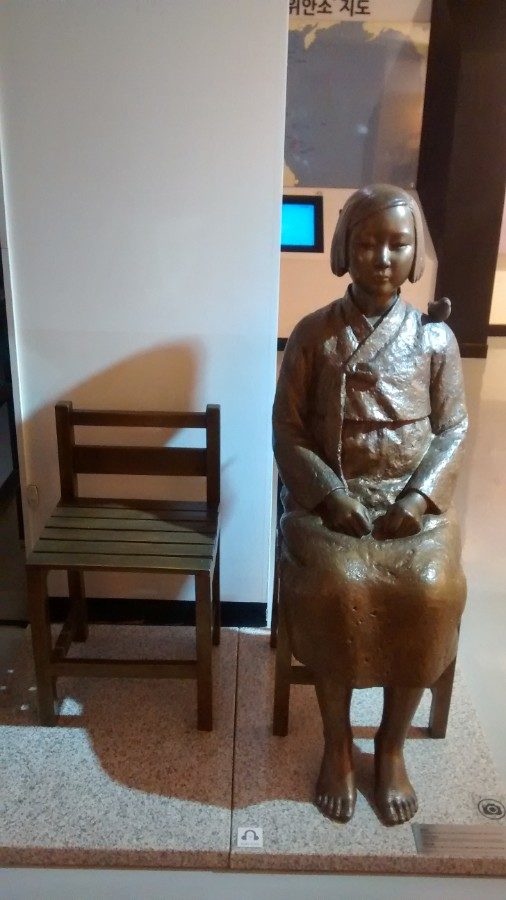
The Peace Statue at the Women and War Museum in Seoul. An identical statue sits outside the Japanese Embassy, Seoul at the spot the Wednesday Protests take place.
Visiting the War and Women’s Human Rights Museum Facilities and Tips
War and Women’s Human Rights Museum 전쟁과여성인권박물관
Address: 20 World Cup buk-ro 11-gil, Mapo-gu, Seoul
Directions: From Hongik University Station Exit 2, take local Mapo bus 15 and get off at Gyeongseong High School intersection, or do a u-turn from the exit and catch green bus 7711, 7016 or 7737 from the stop and get off at the same stop.
Website: http://www.womenandwarmuseum.net (Click on English Language tab at the top)
Opening Hours: 1pm -6pm Tuesday to Saturday
Admission: 3000 Won
Facilities: toilets, museum shop, vending machine, garden
One beautiful gesture that really moved me was my ticket. Upon entering the museum, the staff present you with your ticket. The ticket resembles a bookmark and every day features a different survivor. An absolutely gorgeous physical memento – giving every woman a unique and special voice at last!
Other Related Places to visit in Seoul
If you are interested in human rights, grab yourself a copy of the excellent SEOUL PEACE MAP. This free leaflet also suggests visiting:
The Forest in Memory of Girl (a forest within a public park planted to honour the victims of Japanese Military Sexual Slavery) 32, Jeunsan-ro Mapo-gu Seoul (Sangam-dong 1535) Peace Park.
The Site in Memory (the Gi’eok-ui Teo) is a beautiful, public memorial created on the site of the former Japanese Resident-General’s house. It commemorates not only the 200,000 Korean comfort women but also all the Joseon people who were oppressed by the Japanese colonialists from 1910-1945.
Wednesday Demonstration on Peace Street (Pyeonghwa-ro)
In January 1992, a group of survivors of Japanese Military Sexual Slavery protested in front of the Japanese Embassy in Seoul and demanded that the Japanese government recognise them. This protest has been held every single Wednesday since.
For over 20 years, women and men who care about peace, women’s rights and human dignity have come out be it rain or shine to show their solidarity to the halmonis. See the famous Peace Statue of a Girl and sit next to her to contemplate all those who were lost and all those who still need your support. Come on a Wednesday at midday and join the peace protest. 22 Yul-gok-ru 2-gil, Jongno-gu, Seoul (in front of the Japanese Embassy)
Is the War and Women’s Human Rights Museum suitable for children?
As a family travel blogger, I mostly write about locations that are suitable to visit with young children. However, the War and Women’s Human Rights Museum isn’t. The subject matter is sexual violence, war and slavery. None of the exhibits are too graphic but the place is solemn, small and very emotional.
Babies in slings are welcome and of course, teenagers who will have studied other wartime atrocities at school but definitely find another adult to mind the little ones.
For more information on travelling around South Korea with young children, check out our latest blogs on Why South Korea is a Fantastic Travel Destination for Young Children, Our Top Tips for visiting Seoul with Toddlers, the Perfect Day out in Gyeongju with young children and why we recommend staying in a Log Cabin on Jeju Island, South Korea.
What can I do to support the work of the War and Women’s Human Rights Museum?
The War and Women’s Human Rights Museum is not a place that you can walk away from without some emotional pull. If you’d like to know how you can support their work below are the details of two campaigns that they are currently running.
100 Million Signatures Campaign
Although the Second World War and the Japanese colonialism of South Korea are now far in the depths of history, many of the victims are still alive. Entering old age knowing that their stories have been shared and that people support them gives many of the former ‘comfort women’ hope for their own legacies and for the next generation.
The 100 Million Signatures Campaign is a petition that demands that the Japanese government admits to and makes an official apology for Military Sexual Slavery. It asks for international organisations, like the UN, to put pressure on Japan to do so. If you are interested in adding your signature to the petition and showing solidarity with the surviving ‘comfort women’ please visit www.womenandwar.net/100million/en
The Butterfly Fund
On 8th March 2012 (International Women’s Day), Bok-Dong Kim and Won-Ok Gil, two survivors, made an inspirational pledge. They vowed to donate any reparations that they might one day receive from the Japanese government to support other survivors of wartime sexual violence.
This pledge has been named The Butterfly Fund. The butterflies symbolise women finding their wings and flying free from discrimination, repression and all forms of violence. Although no reparations have yet been received from Japan, generous members of the public have been donating to the fund.
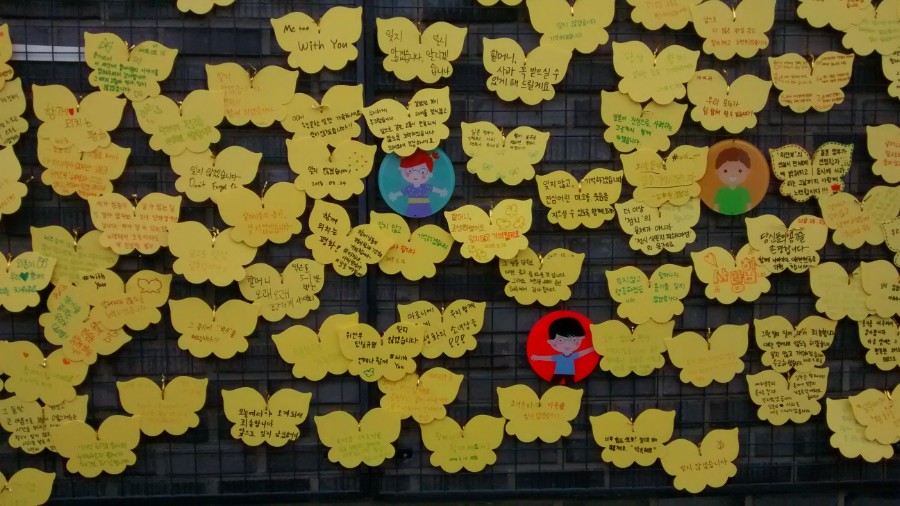
Butterfly cards sharing messages of support and hope
Currently, money raised by The Butterfly Fund goes towards providing support for female victims of the civil war in the Democratic Republic of Congo.
The Butterfly Fund also supports women in Vietnam who suffered sexual assault and worse at the hands of the South Korean Army during the Vietnam War 1964-1973). This is a valiant move by incredibly brave women to atone the horrors perpetrated by their own husbands, sons and brothers.
Find out how you can support this amazing charity at www.facebook.com/groups/HopeNabi or donate via Paypal to [email protected].
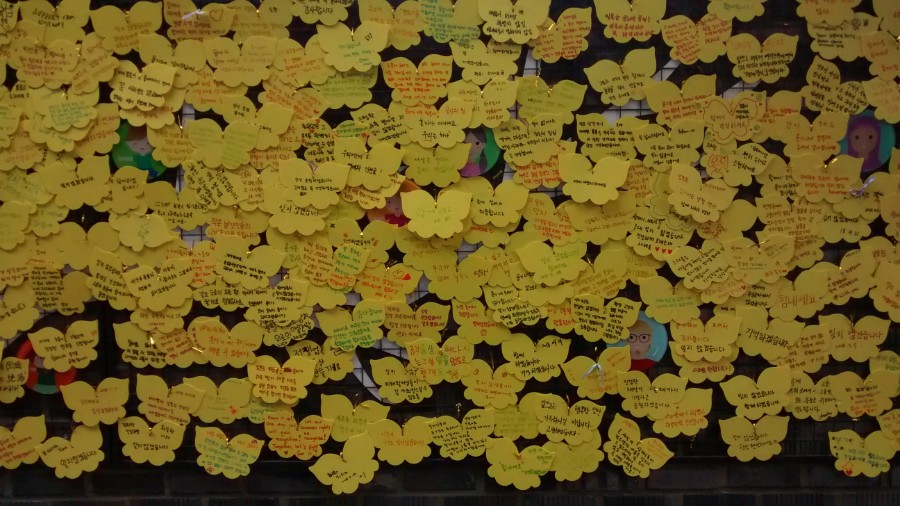
The butterflies symbolise freedom for all female victims of war and slavery.
If you are interested in learning more about the plight of Korean ‘comfort women’ during the Second World War these books come highly recommended and are on my wishlist! If you purchase one of these books through my links, I may receive a very small commission from Amazon at absolutely no cost to you. Thank you for supporting World for a Girl.
Travelling around South Korea with young children?
Check out our latest blogs on Why South Korea is a Fantastic Travel Destination for Young Children, Our Top Tips for visiting Seoul with Toddlers, the Perfect Day out in Gyeongju with young children and why we recommend staying in a Log Cabin on Jeju Island, South Korea.
Welcome to the World for a Girl community where we try to weave family travel and feminism together to educate our readers about women’s rights around the world.
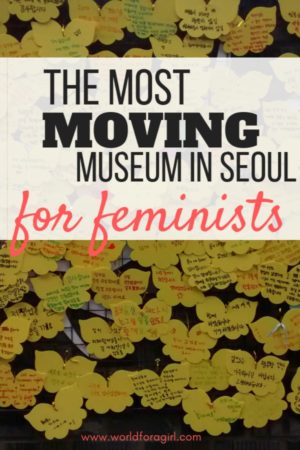
If you have been to the War and Women’s Human Rights Museum, Seoul please comment below and let us know about your visit. Do you have any additional thoughts or tips about a visit to the War and Women’s Human Rights Museum, Seoul?

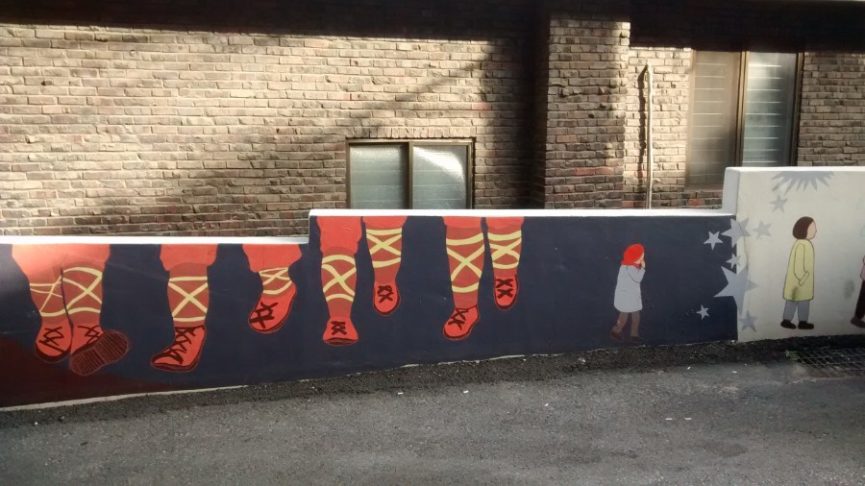
6 Comments on “Why YOU must visit The War and Women’s Human Rights Museum in Seoul”
The story of ‘comfort women’ definitley needs to be told, however shocking and upsetting it is to hear. Although I’ve read a lot about the history, I’ve never been here so will try to visit next time I’m in Korea!
Pingback: World for a Girl - Family Travel Review 2018 - World for a Girl
Pingback: Women's History: FREE online learning resources for kids - World for a Girl
Pingback: Magnificent Women: Monuments, Museums and Murals - World for a Girl
Pingback: Awesome Things to do in Taipei with Kids - World for a Girl
Pingback: Awesome Cities in Asia to Explore with Kids - World for a Girl